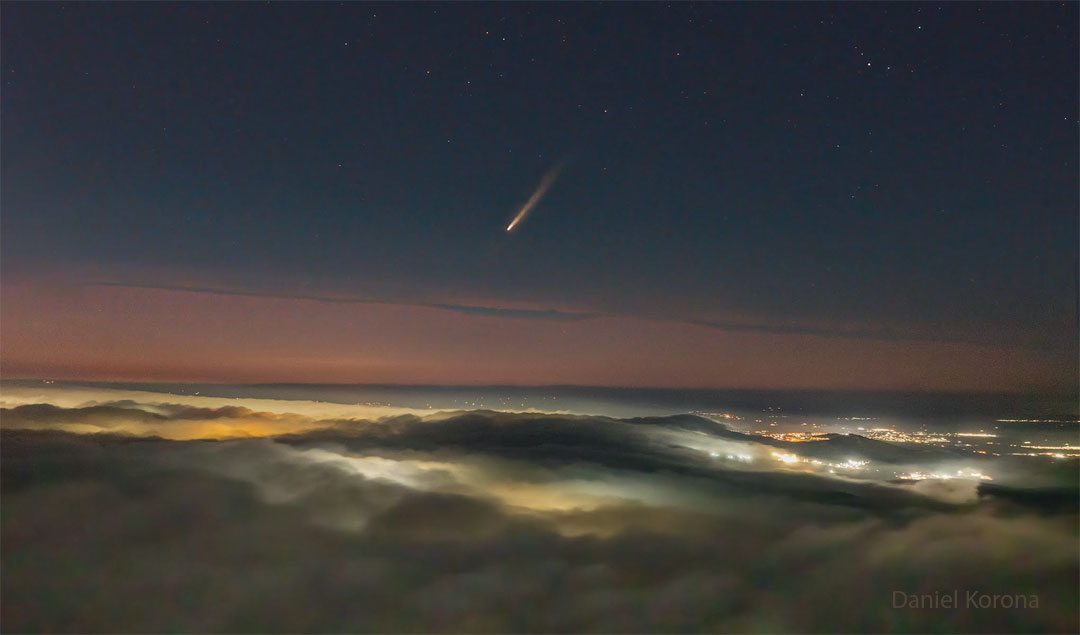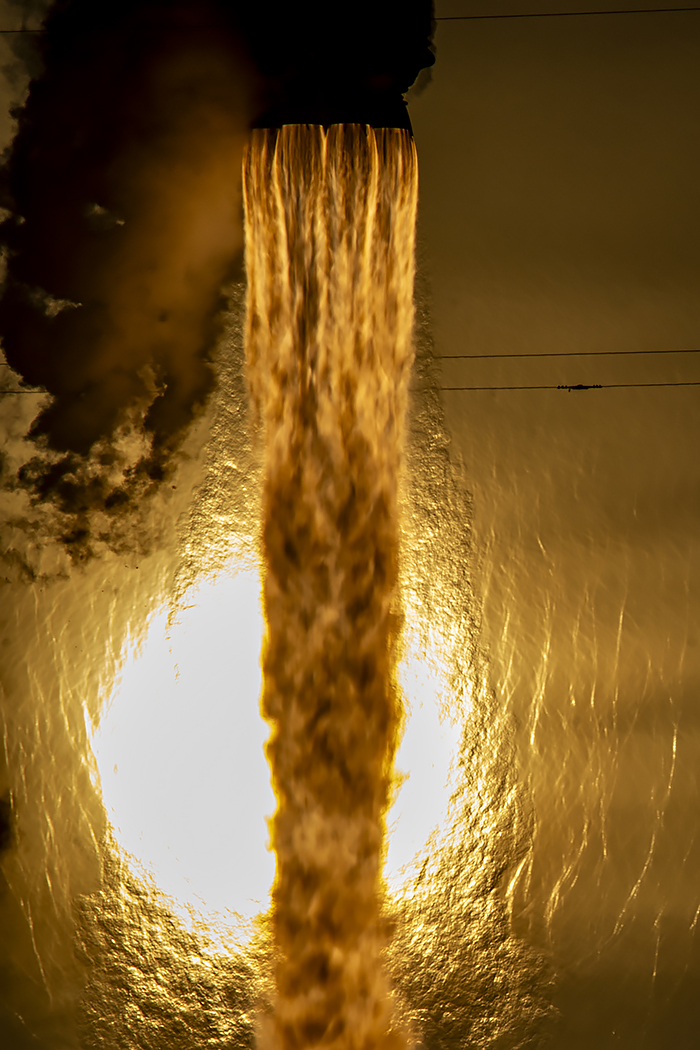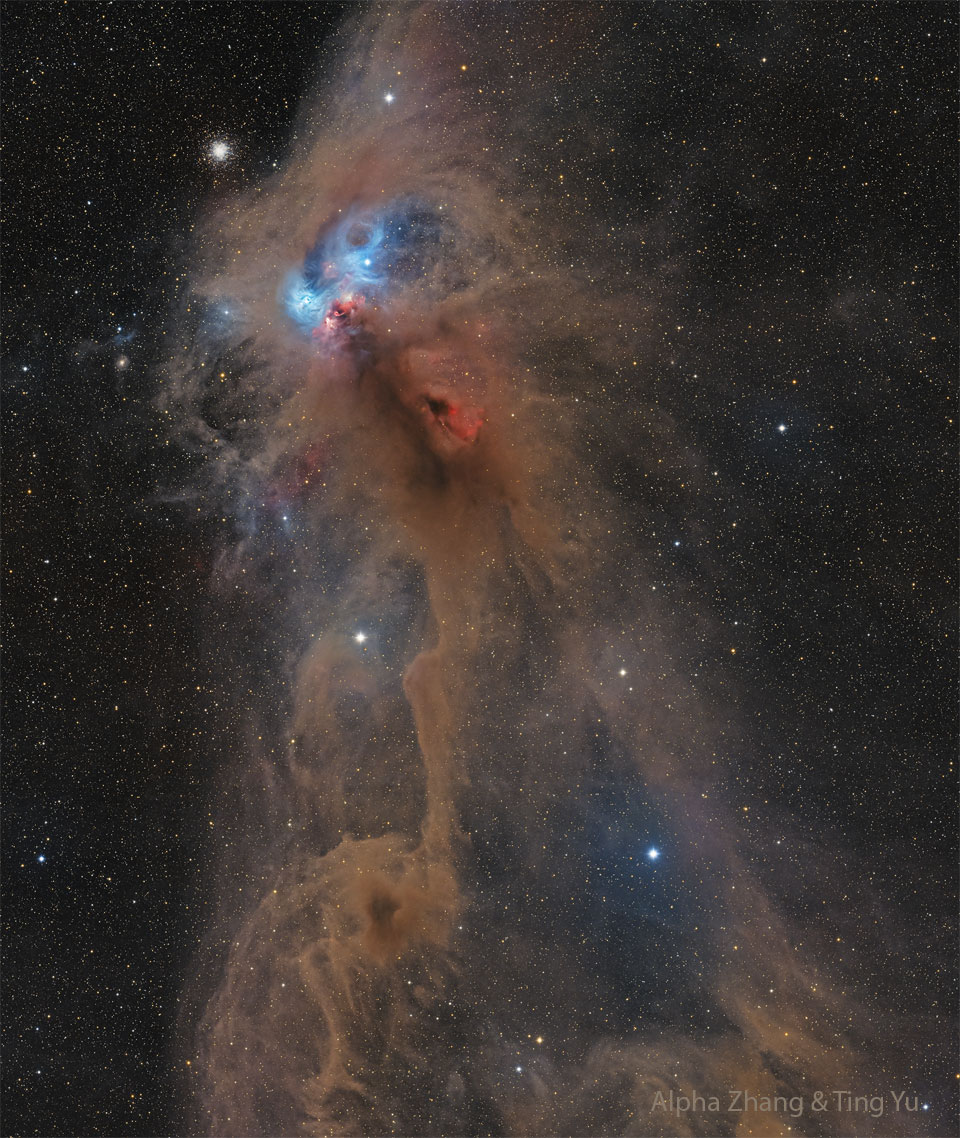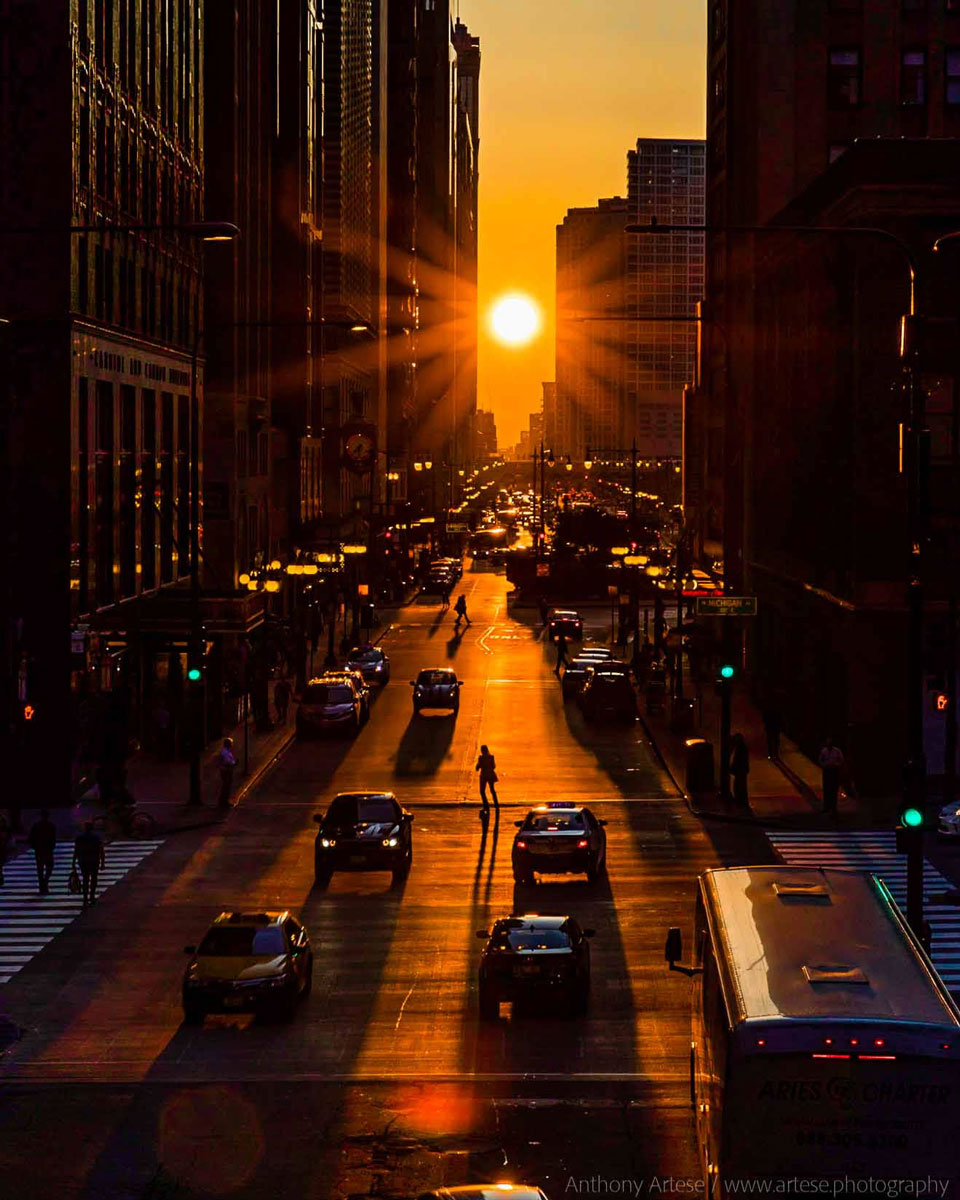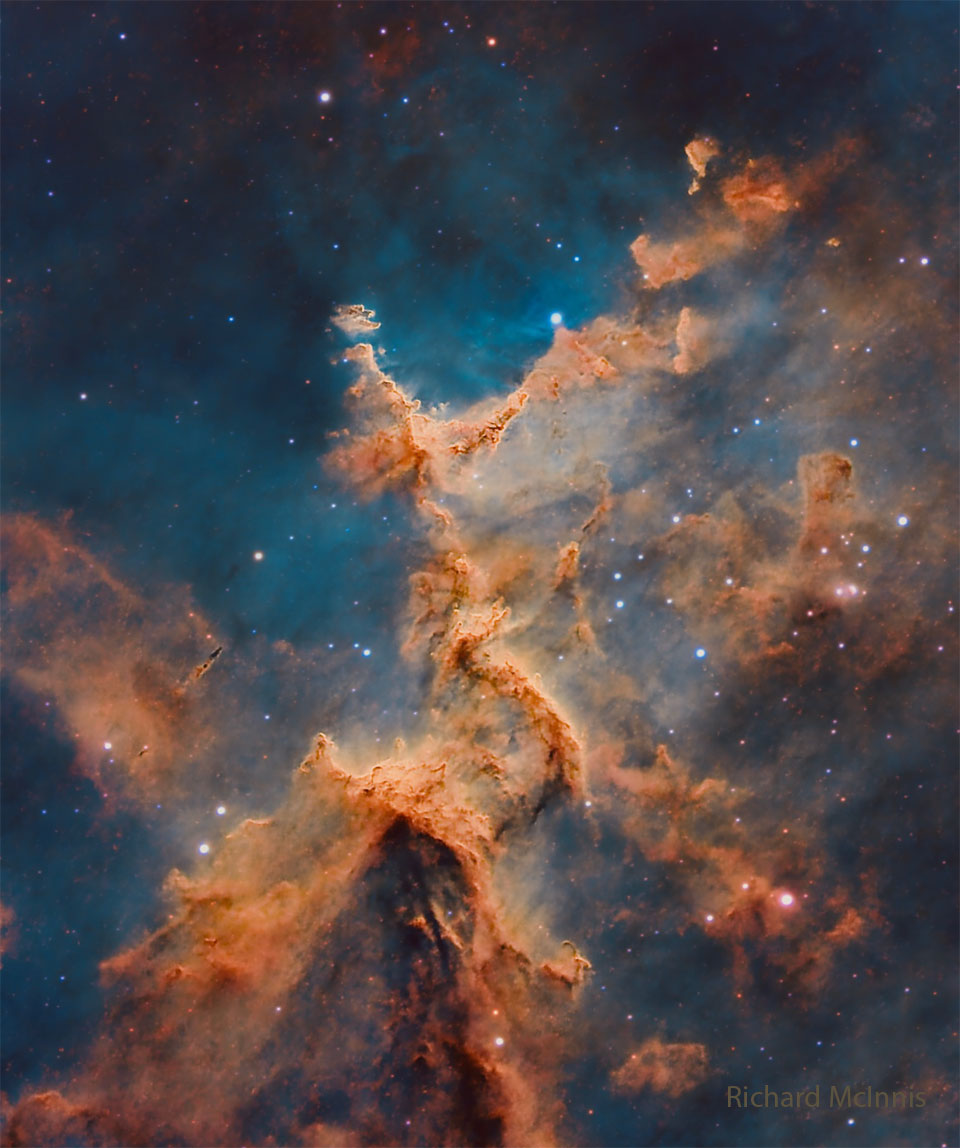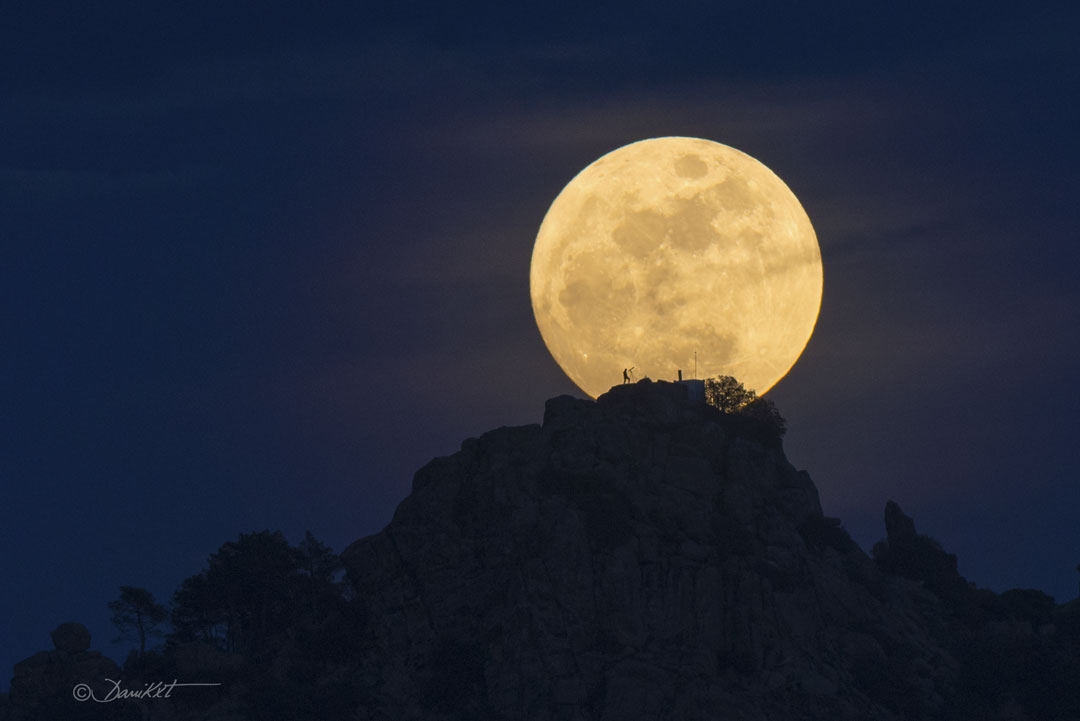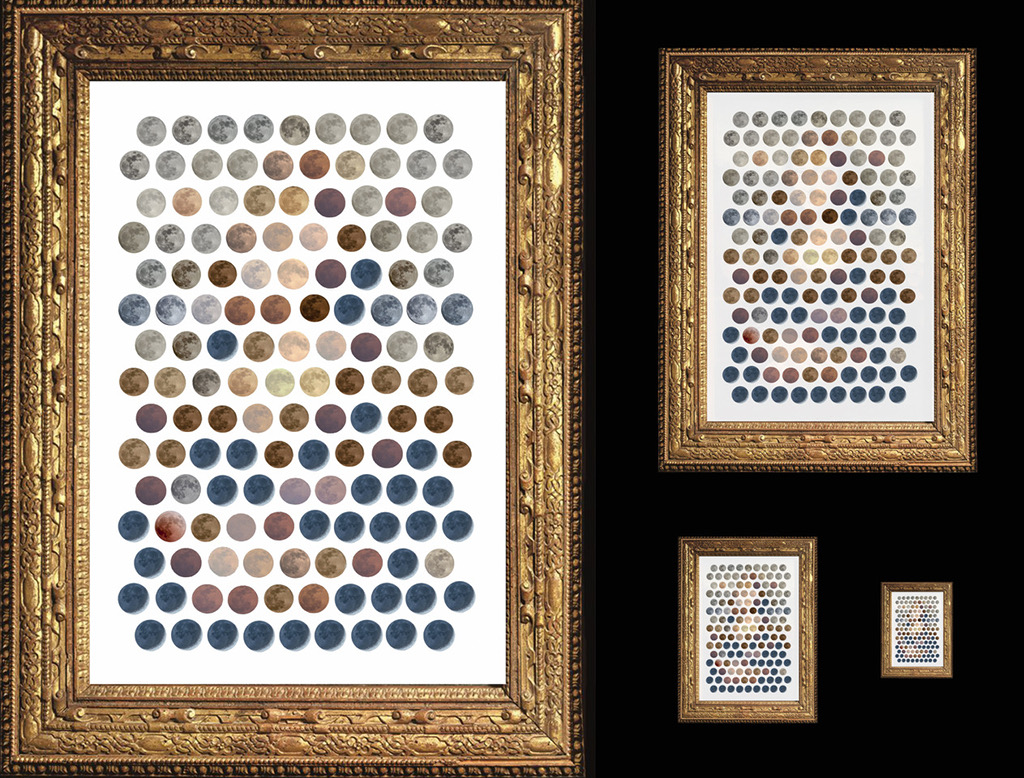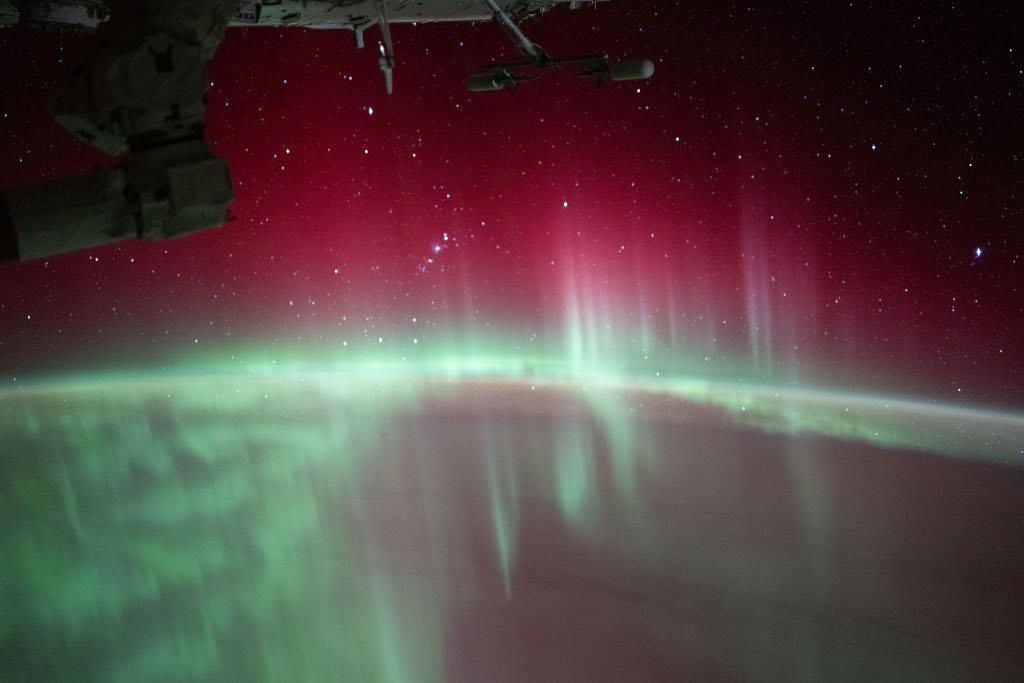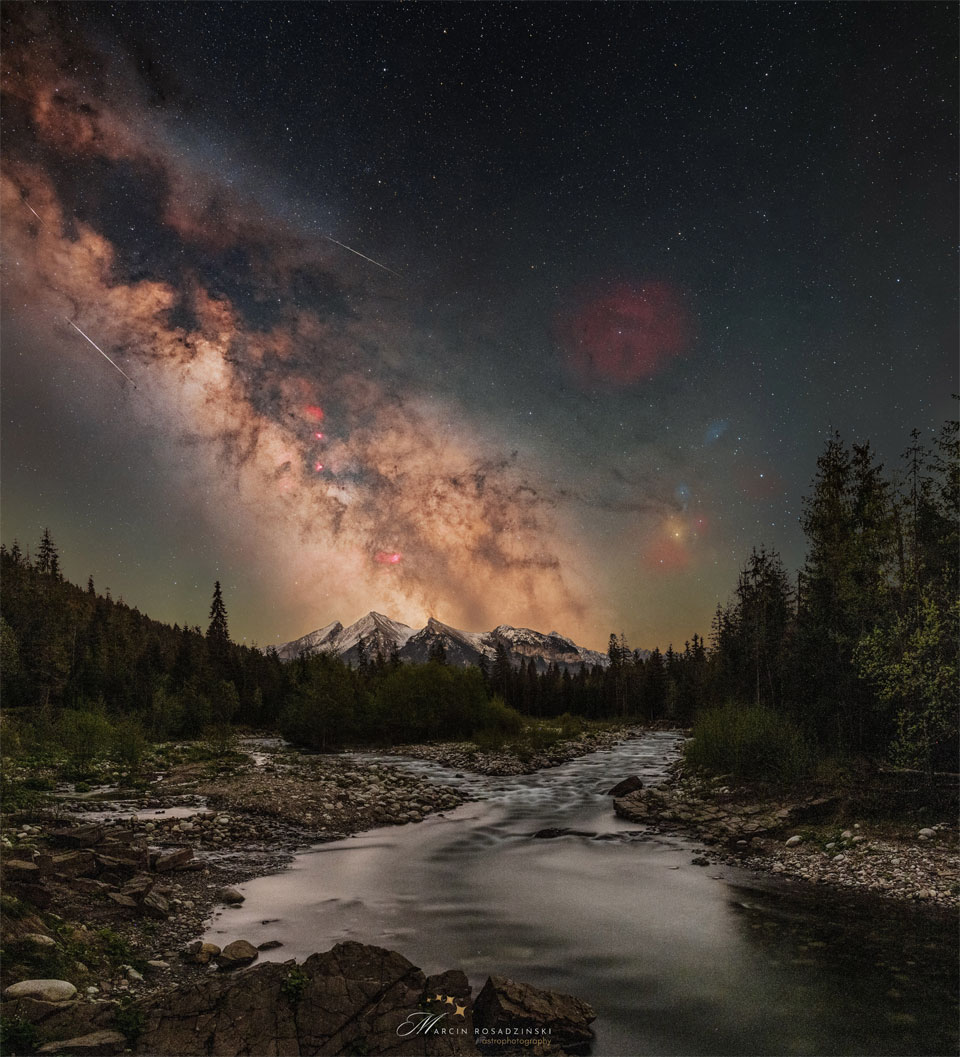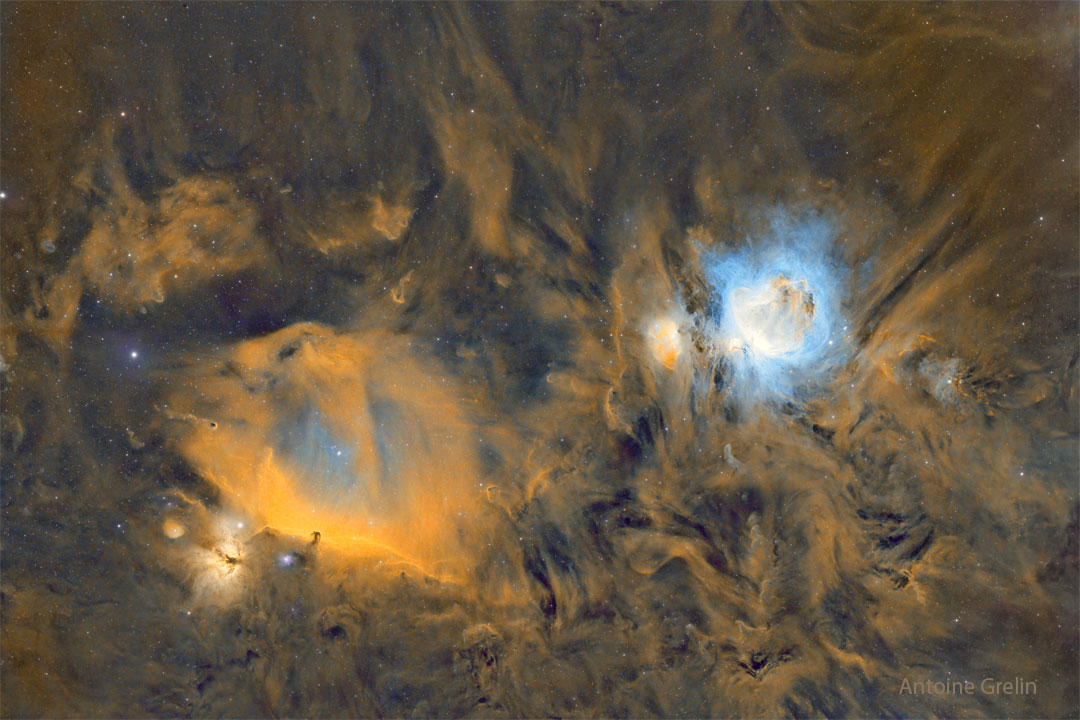Nombre total de pages vues
30/09/2024
LES NUAGES - DIEUX DU CIEL - Nuage lenticulaire sur le mont Cook en Nouvelle-Zélande
INVENTIONS A L'HORIZON 2050 - Les ponts qui s'auto-réparent
ASTRONOMY - Comet Tsuchinshan-ATLAS over Mexico
2024 September 30
Image Credit & Copyright: Daniel Korona
Explanation: The new comet has passed its closest to the Sun and is now moving closer to the Earth. C/2023 A3 (Tsuchinshan–ATLAS) is currently moving out from inside the orbit of Venus and on track to pass its nearest to the Earth in about two weeks. Comet Tsuchinshan-ATLAS, pronounced "Choo-cheen-shahn At-less,", is near naked-eye visibility and easily picked up by long-exposure cameras. The comet can also now be found by observers in Earth's northern hemisphere as well as the south. The featured image was captured just a few days ago above Zacatecas, Mexico. Because clouds were obscuring much of the pre-dawn sky, the astrophotographer released a drone to take pictures from higher up, several of which were later merged to enhance the comet's visibility. Although the future brightness of comets is hard to predict, there is increasing hope that Comet Tsuchinshan-ATLAS will further brighten as it enters the early evening sky.
29/09/2024
MUSIQUE - Scott Joplin - The entertainer
Scott Joplin (entre juillet 1867 et janvier 1868 - 1er avril 1917) était un compositeur et pianiste afro-américain, né près de Texarkana, au Texas, dans la première génération post-esclavagiste. Il est devenu célèbre pour ses compositions uniques de ragtime et a été surnommé le « roi du ragtime ». Au cours de sa brève carrière, il a écrit quarante-quatre pièces originales de ragtime, un ballet de ragtime et deux opéras. L’une de ses premières pièces, le « Maple Leaf Rag », est devenue le premier et le plus influent succès du ragtime, et l’est restée pendant un siècle.
ASTRONOMY - Seven Dusty Sisters
2024 September 29
Image Credit: WISE, IRSA, NASA; Processing & Copyright : Francesco Antonucci
Explanation: Is this really the famous Pleiades star cluster? Known for its iconic blue stars, the Pleiades is shown here in infrared light where the surrounding dust outshines the stars. Here, three infrared colors have been mapped into visual colors (R=24, G=12, B=4.6 microns). The base images were taken by NASA's orbiting Wide Field Infrared Survey Explorer (WISE) spacecraft. Cataloged as M45 and nicknamed the Seven Sisters, the Pleiades star cluster is by chance situated in a passing dust cloud. The light and winds from the massive Pleiades stars preferentially repel smaller dust particles, causing the dust to become stratified into filaments, as seen. The featured image spans about 20 light years at the distance of the Pleiades, which lies about 450 light years distant toward the constellation of the Bull (Taurus).
28/09/2024
SANTé/MEDECINE - ALIMENTATION - NUTRIMENTS - Les vitamines : des petites molécules aux grandes responsabilités
INVENTIONS A L'HORIZON 2050 - Dévier les cyclones pour éviter les catastrophes
ASTRONOMY - Rocket Eclipse at Sunset
Image Credit & Copyright: Ben Cooper (Launch Photography)
Explanation: Shockwaves ripple across the glare as a launch eclipses the setting Sun in this exciting close-up. Captured on September 17, the roaring Falcon 9 rocket carried European Galileo L13 navigation satellites to medium Earth orbit after a lift-off from Cape Canaveral on Florida's space coast. The Falcon 9 booster returned safely to Earth about 8.5 minutes later, notching the 22nd launch and landing for the reusable workhorse launch vehicle. But where did it land? Just Read the Instructions.
27/09/2024
SANTé/MEDECINE - ALIMENTATION - NUTRIMENTS - Les lipides : un carburant essentiel pour l'organisme
ASTRONOMY - Stellar Streams in the Local Universe
2024 September 27
Image Credit: David Martinez Delgado et al.
Explanation: The twenty galaxies arrayed in these panels are part of an ambitious astronomical survey of tidal stellar streams. Each panel presents a composite view; a deep, inverted image taken from publicly available imaging surveys of a field that surrounds a nearby massive galaxy image. The inverted images reveal faint cosmic structures, star streams hundreds of thousands of light-years across, that result from the gravitational disruption and eventual merger of satellite galaxies in the local universe. Such surveys of mergers and gravitational tidal interactions between massive galaxies and their dwarf satellites are crucial guides for current models of galaxy formation and cosmology. Of course, the detection of stellar streams in the neighboring Andromeda Galaxy and our own Milky Way also offers spectacular evidence for ongoing satellite galaxy disruption within our more local galaxy group.
26/09/2024
SANTé/MEDECINE - ALIMENTATION - NUTRIMENTS - Les fibres : nos alliées pour un bon transit
LES NUAGES - DIEUX DU CIEL - Nuage irisé très coloré
PLANTES FASCINANTES - Fleur de la Passion. La fleur dans la démesure : des étamines et un pistil énormes
ASTRONOMY - The Great Globular Cluster in Hercules
2024 September 26
Image Credit & Copyright: Jan Beckmann, Julian Zoller, Lukas Eisert, Wolfgang Hummel
Explanation: In 1716, English astronomer Edmond Halley noted, "This is but a little Patch, but it shows itself to the naked Eye, when the Sky is serene and the Moon absent." Of course, M13 is now less modestly recognized as the Great Globular Cluster in Hercules, one of the brightest globular star clusters in the northern sky. Sharp telescopic views like this one reveal the spectacular cluster's hundreds of thousands of stars. At a distance of 25,000 light-years, the cluster stars crowd into a region 150 light-years in diameter. Approaching the cluster core, upwards of 100 stars could be contained in a cube just 3 light-years on a side. For comparison, the closest star to the Sun is over 4 light-years away. The deep, wide-field image also reveals distant background galaxies including NGC 6207 at the upper left, and faint, foreground Milky Way dust clouds known to some as integrated flux nebulae.
25/09/2024
SANTé/MEDECINE - ALIMENTATION - NUTRIMENTS - Les antioxydants : les protecteurs contre le stress cellulaire
POISSONS EXOTIQUES - Le chirurgien à voile indien
ASTRONOMY - Comet A3 Through an Australian Sunrise
2024 September 25
Image Credit & Copyright: Lucy Yunxi Hu
Explanation: Comet Tsuchinshan-ATLAS is now visible in the early morning sky. Diving into the inner Solar System at an odd angle, this large dirty iceberg will pass its closest to the Sun -- between the orbits of Mercury and Venus -- in just two days. Long camera exposures are now capturing C/2023 A3 (Tsuchinshan–ATLAS), sometimes abbreviated as just A3, and its dust tail before and during sunrise. The featured image composite was taken four days ago and captured the comet as it rose above Lake George, NSW, Australia. Vertical bands further left are images of the comet as the rising Sun made the predawn sky increasingly bright and colorful. Just how bright the comet will become over the next month is currently unknown as it involves how much gas and dust the comet's nucleus will expel. Optimistic skywatchers are hoping for a great show where Tsuchinshan–ATLAS creates dust and ion tails visible across Earth's sky and becomes known as the Great Comet of 2024.
24/09/2024
LES NUAGES DIEUX DU CIEL- Nuage lenticulaire au-dessus du lac Laguna Verde en Bolivie
ASTRONOMY - NGC 6727: The Rampaging Baboon Nebula
2024 September 24
Image Credit & Copyright: Alpha Zhang & Ting Yu
Explanation: This dusty region is forming stars. Part of a sprawling molecular cloud complex that resembles, to some, a rampaging baboon, the region is a relatively close by 500 light-years away toward the constellation Corona Australis. That's about one third the distance of the more famous stellar nursery known as the Orion Nebula. Mixed with bright nebulosities, the brown dust clouds effectively block light from more distant background stars in the Milky Way and obscure from view embedded stars still in the process of formation. The eyes of the dust creature in the featured image are actually blue reflection nebulas cataloged as NGC 6726, 6727, 6729, and IC 4812, while the red mouth glows with light emitted by hydrogen gas. Just to the upper left of the baboon's head is NGC 6723, a whole globular cluster of stars nearly 30,000 light years in the distance.
23/09/2024
SANTé/MEDECINE - ALIMENTATION - NUTRIMENTS - Les glucides : premières réserves énergétiques du corps
LES NUAGES - DIEUX DU CIEL - Somptueux nuage rouge dans le ciel (cumulus)
ASTRONOMY - Comet Tsuchinshan-ATLAS Approaches
2024 September 23
Image Credit & Copyright: Brian Valente & Greg Stein
Explanation: What will happen as this already bright comet approaches? Optimistic predictions have Comet C/2023 A3 (Tsuchinshan–ATLAS) briefly becoming easily visible to the unaided eye -- although the future brightness of comets are notoriously hard to predict, and this comet may even break up in warming sunlight. What is certain is that the comet is now unexpectedly bright and is on track to pass its closest to the Sun (0.39 AU) later this week and closest to the Earth (0.47 AU) early next month. The featured image was taken in late May as Comet Tsuchinshan–ATLAS, discovered only last year, passed nearly in front of two distant galaxies. The comet can now be found with binoculars in the early morning sky rising just before the Sun, while over the next few weeks it will brighten as it moves to the early evening sky.
22/09/2024
INVENTIONS A L'HORIZON 2050 - Exploiter le minerai de la lune
ASTRONOMY - Chicagohenge: Equinox in an Aligned City
2024 September 22
Image Credit & Copyright: Anthony Artese
Explanation: Chicago, in a way, is like a modern Stonehenge. The way is east to west, and the time is today. Today, and every equinox, the Sun will set exactly to the west, everywhere on Earth. Therefore, today in Chicago, the Sun will set directly down the long equatorially-aligned grid of streets and buildings, an event dubbed #chicagohenge. Featured here is a Chicago Henge picture taken during the equinox in mid-September of 2017 looking along part of Upper Wacker Drive. Many cities, though, have streets or other features that are well-aligned to Earth's spin axis. Therefore, quite possibly, your favorite street may also run east - west. Tonight at sunset, with a quick glance, you can actually find out.
17/09/2024
PLANTES FASCINANTES - Un bourdon ? non - c'est l'orchidée Orphrys bombyliflora
ASTRONOMY - Melotte 15 in the Heart Nebula
2024 September 17
Image Credit & Copyright: Richard McInnis
Explanation: Cosmic clouds form fantastic shapes in the central regions of emission nebula IC 1805. The clouds are sculpted by stellar winds and radiation from massive hot stars in the nebula's newborn star cluster, Melotte 15. About 1.5 million years young, the cluster stars are scattered in this colorful skyscape, along with dark dust clouds in silhouette against glowing atomic gas. A composite of narrowband and broadband telescopic images, the view spans about 15 light-years and includes emission from ionized hydrogen, sulfur, and oxygen atoms mapped to green, red, and blue hues in the popular Hubble Palette. Wider field images reveal that IC 1805's simpler, overall outline suggests its popular name - the Heart Nebula. IC 1805 is located about 7,500 light years away toward the boastful constellation Cassiopeia.
16/09/2024
INVENTIONS A L'HORIZON 2050 - Une mini centrale nucléaire en kit
ASTRONOMY - Mercury's Vivaldi Crater from BepiColombo
2024 September 16
Image Credit: ESA, JAXA, BepiColombo, MTM
Explanation: Why does this large crater on Mercury have two rings and a smooth floor? No one is sure. The unusual feature called Vivaldi Crater spans 215 kilometers and was imaged again in great detail by ESA's and JAXA's robotic BepiColombo spacecraft on a flyby earlier this month. A large circular feature on a rocky planet or moon is usually caused by either an impact by a small asteroid or a comet fragment, or a volcanic eruption. In the case of Vivaldi, it is possible that both occurred -- a heavy strike that caused a smooth internal lava flow. Double-ringed craters are rare, and the cause of the inner rings remains a topic of research. The speed-slowing gravity-assisted flyby of Mercury by BepiColombo was in preparation for the spacecraft entering orbit around the Solar System's innermost planet in 2026.
15/09/2024
INVENTIONS A L'HORIZON 2050 - La ferme verticale nourrira les citadins
ASTRONOMY - Find the Man in the Moon
2024 September 15
Image Credit & Copyright: Dani Caxete
Explanation: Have you ever seen the Man in the Moon? This common question plays on the ability of humans to see pareidolia -- imagining familiar icons where they don't actually exist. The textured surface of Earth's full Moon is home to numerous identifications of iconic objects, not only in modern western culture but in world folklore throughout history. Examples, typically dependent on the Moon's perceived orientation, include the Woman in the Moon and the Rabbit in the Moon. One facial outline commonly identified as the Man in the Moon starts by imagining the two dark circular areas -- lunar maria -- here just above the Moon's center, to be the eyes. Surprisingly, there actually is a man in this Moon image -- a close look will reveal a real person -- with a telescope -- silhouetted against the Moon. This well-planned image was taken in 2016 in Cadalso de los Vidrios in Madrid, Spain.
14/09/2024
ASTRONOMY - The Moona Lisa
2024 September 14
Image Credit & Copyright: Gianni Sarcone and Marcella Giulia Pace
Explanation: Only natural colors of the Moon in planet Earth's sky appear in this creative visual presentation. Arranged as pixels in a framed image, the lunar disks were photographed at different times. Their varying hues are ultimately due to reflected sunlight affected by changing atmospheric conditions and the alignment geometry of Moon, Earth, and Sun. Here, the darkest lunar disks are the colors of earthshine. A description of earthshine, in terms of sunlight reflected by Earth's oceans illuminating the Moon's dark surface, was written over 500 years ago by Leonardo da Vinci. But stand farther back from your screen or just shift your gaze to the smaller versions of the image. You might also see one of da Vinci's most famous works of art.
13/09/2024
PLANTES FASCINANTES - Rafflesia zollingeriana - la plus grande plante du monde
ASTRONOMY - Aurora Australis and the International Space Station
2024 September 13
Image Credit: NASA, ISS Expedition 71
Explanation: This snapshot from the International Space Station was taken on August 11 while orbiting about 430 kilometers above the Indian Ocean, Southern Hemisphere, planet Earth. The spectacular view looks south and east, down toward the planet's horizon and through red and green curtains of aurora australis. The auroral glow is caused by emission from excited oxygen atoms in the extremely rarefied upper atmosphere still present at the level of the orbiting outpost. Green emission from atomic oxygen dominates this scene at altitudes of 100 to 250 kilometers, while red emission from atomic oxygen can extend as high as 500 kilometers altitude. Beyond the glow of these southern lights, this view from low Earth orbit reveals the starry sky from a southern hemisphere perspective. Stars in Orion's belt and the Orion Nebula are near the Earth's limb just left of center. Sirius, alpha star of Canis Major and brightest star in planet Earth's night is above center along the right edge of the southern orbital skyscape.
INVENTIONS A L'HORIZON 2050 - Le robot ouvrier envahira les usines
12/09/2024
ASTRONOMY - Young Star Cluster NGC 1333
2024 September 12
Image Credit: ESA/Webb, NASA, CSA, A. Scholz, K. Muzic, A. Langeveld, R. Jayawardhana
Explanation: This spectacular mosaic of images from the James Webb Space Telescope peers into the heart of young star cluster NGC 1333. A mere 1,000 light-years distant toward the heroic constellation Perseus, the nearby star cluster lies at the edge of the large Perseus molecular cloud. Part of Webb's deep exploration of the region to identify low mass brown dwarf stars and free floating planets, the space telescope's combined field of view spans nearly 2 light-years across the dusty cluster's turbulent stellar nursery. In fact, NGC 1333 is known to harbor stars less than a million years old, though most are hidden from optical telescopes by the pervasive stardust. The chaotic environment may be similar to one in which our own Sun formed over 4.5 billion years ago.
11/09/2024
POISSONS EXOTIQUES - Le baliste clown
ASTRONOMIE NEWS - L’éclipse partielle de Lune du 18 septembre 2024

ASTRONOMY - A Night Sky over the Tatra Mountains
2024 September 11
Image Credit: Marcin Rosadziński; Text: Natalia Lewandowska (SUNY Oswego)
Explanation: A natural border between Slovakia and Poland is the Tatra Mountains. A prominent destination for astrophotographers, the Tatras are the highest mountain range in the Carpathians. In the featured image taken in May, one can see the center of our Milky Way galaxy with two of its famous stellar nurseries, the Lagoon and Omega Nebula, just over the top of the Tatras. Stellar nurseries are full of ionized hydrogen, a fundamental component for the formation of Earth-abundant water. As a fundamental ingredient in all known forms of life, water is a crucial element in the Universe. Such water can be seen in the foreground in the form of the Bialka River.
10/09/2024
PLANTES FASCINANTES - Hoya carnosa
ASTRONOMIE - Préparez-vous : une nouvelle étoile va apparaître dans le ciel d'un jour à l'autre !
ASTRONOMY - Horsehead and Orion Nebulas
2024 September 10
Image Credit & Copyright: Antoine & Dalia Grelin
Explanation: The dark Horsehead Nebula and the glowing Orion Nebula are contrasting cosmic vistas. Adrift 1,500 light-years away in one of the night sky's most recognizable constellations, they appear in opposite corners of the above stunning mosaic. The familiar Horsehead nebula appears as a dark cloud, a small silhouette notched against the long glow of hydrogen -- here shown in gold -- at the lower left. Alnitak is the easternmost star in Orion's belt and is seen as the bright star to the left of the Horsehead. Just below Alnitak is the Flame Nebula, with clouds of bright emission and dramatic dark dust lanes. The magnificent emission region, the Orion Nebula (aka M42), lies at the upper right. Immediately to its left is a prominent reflection nebula sometimes called the Running Man. Pervasive tendrils of glowing hydrogen gas are easily traced throughout the region.
09/09/2024
INVENTIONS A L'HORIZON 2050 - Des aliments sur mesure
ASTRONOMY - The Observable Universe
2025 November 23 The Observable Universe Illustration Credit & Licence : Wikipedia , Pablo Carlos Budassi Explanation: How far can ...

-
2022 September 26 All the Water on Planet Earth Illustration Credit: Jack Cook, Adam Nieman, Woods Hole Oceanographic Institution ; Data ...
-
2025 May 11 The Surface of Venus from Venera 14 Image Credit: Soviet Planetary Exploration Program , Venera 14 ; Processing & Copyri...


